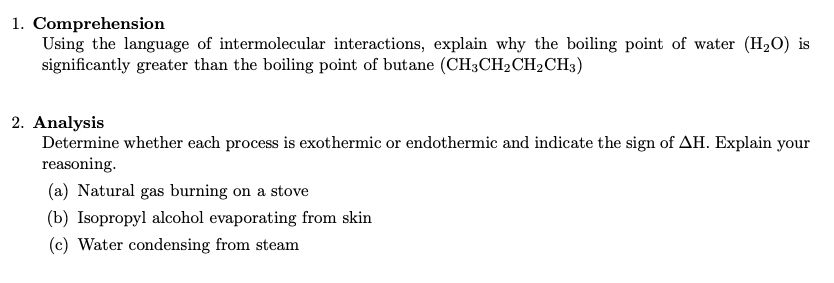SLO 4.1 Molecular Interactions
Students will use knowledge of molecular composition and geometry to describe molecular interactions
 Key Concepts and Skills
Key Concepts and Skills
- Specific Heat Capacity: Explain the differences between heat and temperature. Describe how specific heat capacity is related to the temperature of a substance.
- Intermolecular Forces: Define, give examples of, and rank relative strength of the various molecular attractions known collectively as “intermolecular forces”: dispersion, dipole-dipole attractions, and hydrogen-bonding. Describe the difference between intermolecular and intramolecular forces.
- Heat of Vaporization/Fusion: Describe the relationship between intermolecular forces, phase changes, and heat of vaporization and heat of fusion.
- Heating Curve: Describe the components of a heating curve and explain what it represents. Do this by describing the observed differences in heat exchange due to changes in temperature and bond making/breaking process
- Predict Properties of Molecules: Predict the relative boiling/melting point of a substance and explain trends based on intermolecular forces. Evaluate errors with statements made about intermolecular forces in molecules and predictions of boiling points and trends
 Reading
Reading
- From the textbook:
- 7.3 The First Law of Thermodynamics: There Is No Free Lunch
- 7.4 Quantifying Heat and Work
- 7.6 Enthalpy: The Heat Evolved in a Chemical Reaction at Constant Pressure
- 7.7 Constant-Pressure Calorimetry: Measuring ΔHrxn
- 12.2 Solids, Liquids, and Gases: A Molecular Comparison
- 12.3 Intermolecular Forces: The Forces That Hold Condensed States Together
- 12.5 Vaporization and Vapor Pressure
- 12.6 Sublimation and Fusion
- 12.7 Heating Curve for Water
- POGIL Activities
- CA-25: What Determines a Boiling Point?
- CA-J: What Factors Affect the Amount of Heat Transferred to a System?
- Other:
 Important Terms
Important Terms
| Intermolecular Forces | Heat Curve |
| Intramolecular Forces | Heat Capacity |
| Dispersion forces | Fusion |
| Dipole-Dipole forces | Vaporization |
| Hydrogen Bonding | Freezing |
| Ion-Dipole forces | Condensation |
| Molecular Dipole | Enthalpy |
 Sample Assessment Questions
Sample Assessment Questions

 Dr. Thompson Videos
Dr. Thompson Videos
-
IMF Identification
-
IMFs and Boiling Points
-
IMF Identification - Dipoles and Polarity
-
Heating Curves
 External Videos, Tutorials, Simulations
External Videos, Tutorials, Simulations
- Intermolecular Forces Interactive Activity
- Khan Academy - Heating Curves
- Khan Academy - Intermolecular Forces
- Crash Course Chemistry - Intermolecular Interactions
- PhET - Polarity
 Practice Problems
Practice Problems
- From the textbook:
- Chapter 7: 17, 19, 39, 45, 69, 75
- Chapter 12: 1, 3, 4, 6, 18, 19, 31, 32, 37-39, 43-45, 58
- From other external sources:
- N/A
- From Dr. Thompson (links and embedded versions below):